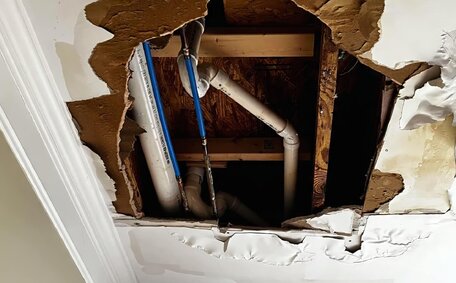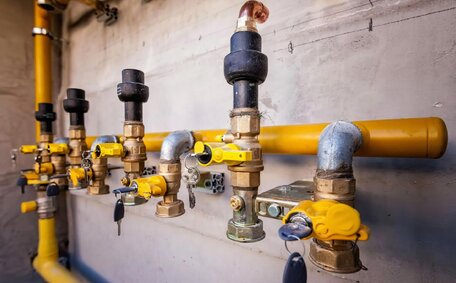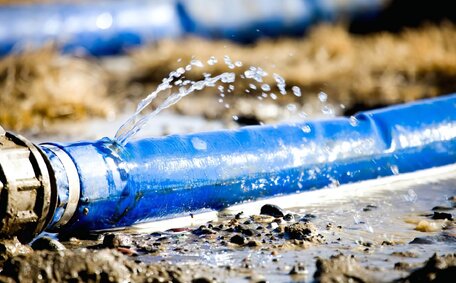Introduction: The Link Between Soil Erosion and Drain Blockages
Soil erosion is a major factor in drain blockages, with stormwater runoff collecting soil particles, organic matter, and debris. Over time, this sediment is transported into gutters, storm drains, and other drainage systems.
Sediment buildup can impair water flow, causing complete or partial drain blockages. Lindfield Plumbing, as the leading plumbing company in Lindfield, often deals with blocked drains related to excess sediment.
This article will examine how sediment enters and clogs drainage systems and offer practical homeowner solutions.
Common Causes of Soil and Sediment Buildup in Drains
Various factors contribute to soil and sediment accumulation in drains, often resulting in clogs and drainage problems.
Stormwater Runoff
Surface water gathers loose topsoil, fine sediment, and debris across various landscapes and urban settings. This polluted runoff enters street gutters and drains, depositing sediment over time. Heavy rainfall following drought conditions can displace large amounts of soil from the hardened ground.
Soil Erosion
Erosion happens as soil particles detach and are carried off by wind or water. Human activities like land clearing, excavation, construction and agriculture can strip away stabilising vegetation and expose soil to erosion. Lindfield’s sloping terrain presents areas where erosion risk is increased.
Sedimentation
Sedimentation occurs when eroded soil particles settle in waterways and infrastructures such as drains and pipes. Sand, silt, and clay particles accumulate progressively, diminishing drainage capacity. Homeowners may notice gurgling sounds, slow draining fixtures or water pooling around drains.
Mitigation Tips
Strategies to curtail sediment include revegetation, silt fencing, slope stabilisation, proper site drainage, and drainage upkeep.
Urban Development and Construction Accelerating Sediment Pollution
Urban development and construction can drastically heighten sediment pollution problems. As land is cleared and soil is exposed, erosion risk grows substantially. Stormwater easily gathers loose sediment, carrying it into drainage systems.
Areas like Lindfield with ongoing residential projects and infrastructure upgrades are especially vulnerable. Steep terrain and high water tables present greater risks for erosion and drainage complications. Inadequate sediment control at construction sites exacerbates runoff pollution, potentially overwhelming drains.
Suggested urban planning initiatives include preserving native vegetation, installing drainage buffers and sediment traps and stabilising exposed soil with mulch or polymers. Builders should adhere to best practice guidelines for erosion and sediment control feature runoff diversion, drainage pits, and site rehabilitation.
Environmental Impact of Sediment in Waterways
Excess sediment flowing into waterways can cause severe impacts on aquatic ecosystems and water quality in numerous ways:
Habitat Degradation
As sediment settles across the water column, riverbeds and lake floors, it smothers important habitat features and aquatic vegetation relied on by fish, invertebrates and other species.
Toxic Contaminants
Fine sediment in mineral soils readily binds to nutrients, metals and other pollutants. Polluted sediment poses significant risks to aquatic ecosystems and water purity.
Trophic Disruption
Washed away suspended sediment clouds water, impairing the feeding of visual predators and disrupting food webs. Photosynthesis also declines due to less light penetration.
Algal Blooms
Nutrient-laden sediment often instigates algal blooms that deplete oxygen and sunlight, harming aquatic life.
Mitigating sediment input through better land use practices is vital for the health of drainage systems and aquatic environments.
Preventing Sediment Blockages at Construction Sites
Construction sites can be major contributors to sediment pollution and blocked drains if soil erosion and stormwater runoff are not adequately controlled. Nevertheless, builders can take several steps to minimise sediment loss:
Erosion Control
Stabilising exposed soil using mulch, polymers, or revegetation is important as water can erode even stable surfaces, intensifying erosion by wind and rainfall. Divert stormwater flows away from stripped areas using buffers, berms and channels.
Sediment Barriers
Use silt fencing, sediment traps, check dams, and barriers to intercept sediment-rich runoff.
Site Drainage
Manage on-site water movement using drainage pits, sediment basins and dewatering equipment so sediment stays contained. Ensure pump outlets prevent sediment discharge.
Stockpile Management
Cover or stabilise soil stockpiles using polymers, tarps or vegetation to minimise erosion. Locate stockpiles away from drainage lines and waterways.
Adhering to best practice sediment control guidelines minimises environmental damage and avoids potential fines, as well as future drain maintenance expenses. Most importantly, preventing sediment from entering street gutters and pipes will avoid exacerbating drainage issues in surrounding areas.
Using Silt Bags to Protect Drains
Silt bags provide a simple but highly effective means of capturing sediment and preventing it from entering and damaging drainage systems. They are typically used on construction sites and other disturbed areas to filter out soil particles from stormwater before it reaches street gutters or storm drains.
How Silt Bags Work
Silt bags are durable woven geotextile bags that are installed around drain inlets. Stormwater flows through the permeable fabric, which traps sediment and other pollutants before they can reach the drainage system. Silt bags are compact and easy to secure with stakes, sandbags, or concrete blocks.
Key Benefits
- Capture over 90% of sediment from runoff
- Prevent sediment buildup and clogging of drains
- Easy to install and maintain around drain openings
- More effective than methods like filter socks
- Portable and adaptable to various site conditions
Besides filtering sediment, silt bags also reduce downslope erosion via natural infiltration. They present a simple but important line of defence for safeguarding drainage infrastructure.
Appropriate Applications
Silt bags have broad utility across various industries and environments where sediment control is needed:
- Construction sites
- Building demolitions
- Land development projects
- Roadworks
- Mining operations
- Agriculture
- Forestry
- Stream and wetland maintenance
Using silt bags improves water quality and protects ecosystems by controlling sediment in runoff.
Mitigating Risks of Land Drainage
Sustainable land drainage management is essential, given the complex relationship among land use, infrastructure, and natural processes. Adopting preventive, low-impact strategies can help mitigate drainage issues and erosion risks over the long term.
Protect Native Vegetation
Preserving native groundcover vegetation and deep-rooted plants stabilises the soil surface, reduces erosion potential and improves natural water infiltration. Vegetation traps sediment, filters runoff and slows water flows.
Install Drainage Controls
Using contour banks, diversion drains, subsurface drainage systems and sediment traps helps safely channel excess water while capturing eroded sediment onsite. Maintenance checks ensure proper functioning.
Stabilise Waterways
Lining drainage channels and strengthening creek banks with rocks, vegetation or geo-textiles curbs erosion damage, especially on steep slopes. Native vegetation further enhances stability.
Mitigate Impacts of Land Use
Sustainable agricultural and land clearing practises reduce soil exposure and compaction. Careful soil and nutrient management also lowers contamination risks. Set aside riparian buffers and wetlands.
Encouraging natural groundcover, responsibly enhancing drainage infrastructure, and stabilising at-risk areas strengthen the landscape’s resilience to extreme weather.
Installing and Maintaining Effective Drainage Systems
Properly installing and regularly maintaining drainage systems is critical for preventing sediment-related clogs and ensuring effective stormwater management. Several key factors should guide drainage infrastructure design and upkeep:
Material Selection
Choose durable materials like reinforced concrete, PVC, HDPE or galvanised steel for pipes, channels and other drainage components. Choose sizes fit to handle peak flow rates. Use corrosion-resistant, high-strength materials in coastal or flood-prone areas.
Installation Factors
Slopes must be designed to enable gravity drainage while preventing too much water speed or erosion. Employ fillets, sandbags or geo-textiles for channel stabilisation. Set adequate pipe cover depth and provide accessible maintenance points via junction boxes and grates.
Preventive Maintenance
Regular drainage inspection and cleaning, when carried out consistently, is vital. Clear leaves, debris and sediment via flushing, suction or manual removal to maintain conveyance capacity. Check and repair sinkholes, leaks, breaks, blockages or vegetation overgrowth promptly.
Upgrade Measures
Consider enhancing capacity via additional pits and pipes or drainage augmentation using rainwater tanks and infiltration systems. Redirect water from problematic zones with landscaping and barriers. Improving surrounding soil stability curbs sediment inputs.
Investing in robust drainage systems and keeping them debris-free through vigilant maintenance safeguards infrastructure integrity and averts flood risks from sediment obstructions during extreme weather.
When to Call a Professional for Blocked Drains
Blocked drains caused by excessive soil, sediment, leaves, or debris can lead to flooding, unhealthy water pooling, sewage backups, and damage to your home’s plumbing system if left untreated. As a homeowner, knowing when to call for professional drain servicing is crucial.
You should contact Lindfield Plumbing if you notice any of the following signs of a drainage blockage:
- Water pooling around drains following rain
- Gurgling noises from toilet bowls or sink drains
- Foul sewage odours coming from drains
- Backed up sinks, tubs, or toilets inside
- Markedly slow drainage in home fixtures
Our skilled technicians possess the expertise and tools needed to clear drains and pipes blocked by sediment and debris. We inspect drainage lines, power-wash clogs, extract roots and waste, restoring free flow to your home’s plumbing. Contact Lindfield Plumbing today at 1300 349 338 or [email protected] for urgent assistance.






